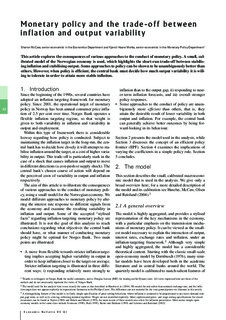| dc.contributor.author | McCaw, Sharon | |
| dc.contributor.author | Morka, Kjersti Haare | |
| dc.date.accessioned | 2018-07-04T12:36:30Z | |
| dc.date.available | 2018-07-04T12:36:30Z | |
| dc.date.issued | 2005 | |
| dc.identifier.issn | 0029-1676 | |
| dc.identifier.uri | http://hdl.handle.net/11250/2504380 | |
| dc.description.abstract | This article explores the consequences of various approaches to the conduct of monetary policy. A small, calibrated model of the Norwegian economy is used, which highlights the short-run trade-off between stabilising inflation and stabilising output. Some approaches to policy can be shown to be unambiguously better than others. However, when policy is efficient, the central bank must decide how much output variability it is willing to tolerate in order to attain more stable inflation. | nb_NO |
| dc.language.iso | eng | nb_NO |
| dc.publisher | Norges Bank | nb_NO |
| dc.rights | Attribution-NonCommercial-NoDerivatives 4.0 Internasjonal | * |
| dc.rights.uri | http://creativecommons.org/licenses/by-nc-nd/4.0/deed.no | * |
| dc.title | Monetary Policy and the Trade-Off Between Inflation and Output Variability | nb_NO |
| dc.type | Journal article | nb_NO |
| dc.subject.nsi | VDP::Samfunnsvitenskap: 200::Økonomi: 210::Samfunnsøkonomi: 212 | nb_NO |
| dc.source.pagenumber | 42-49 | nb_NO |
| dc.source.journal | Economic Bulletin | nb_NO |
| dc.source.issue | 1/2005 | nb_NO |

